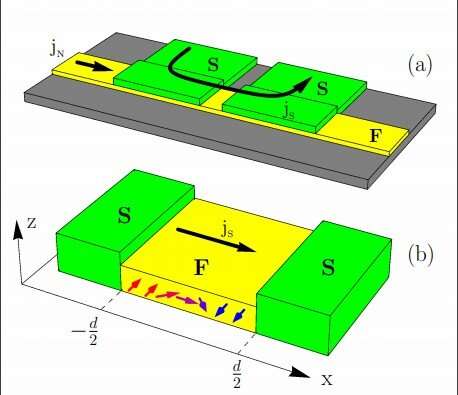Josephson Junction. Credit: The University of Jyväskylä/ Mihail Silaev
Physicists have shown that the motion of domain walls can be detected by monitoring voltage generated in superconducting devices. This finding can facilitate magnetic racetrack memory applications. The result was published in Physical Review Letters. The international research group included researchers from the University of Jyväskylä.
Recently many research groups have aimed at developing magnetic memories which are based on writing and reading magnetic information with the help of electric current. Such systems typically require such large amounts of current to switch magnetization that it can affect the thermal stability of the memory element. In order to reduce heating effects, superconducting materials which can sustain dissipationless electric current would be very useful.
Superconducting current is a flow of electrons bound in Cooper pairs, and therefore is fundamentally different from the usual current in normal metals which is carried by single electrons. Therefore, in order to develop a superconductor/ferromagnet memory element it has been necessary to understand how superconducting current can affect magnetic state.
In their paper, the research group has found answers to two fundamental questions: whether supercurrent can change magnetic states, and whether it is possible to avoid electric losses during this process.
"We have developed the theory which describes how the superconductor can lose its fundamental property of having zero resistance in a typical superconductor/ferromagnet device. This happens because of the induced magnetization dynamics in the attached ferromagnet. Although the force which drives magnetization comes from the superconducting current, the system becomes inherently dissipative and in principle cannot sustain any amount of superconducting current because of the voltage generated by the magnetization dynamics," explains Academy Research Fellow Mihail Silaev.
"We find the low-current resistance associated with the domain wall motion driven by the superconducting current. We suggest the finite slope of Shapiro steps as the characteristic feature of the regime with domain wall oscillations driven by the external current flowing through the junction," Silaev concludes.
More information: D. S. Rabinovich et al, Resistive State of Superconductor-Ferromagnet-Superconductor Josephson Junctions in the Presence of Moving Domain Walls, Physical Review Letters (2019). DOI: 10.1103/PhysRevLett.123.207001
Journal information: Physical Review Letters
Provided by University of Jyväskylä
























